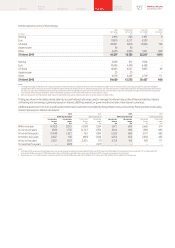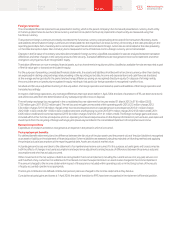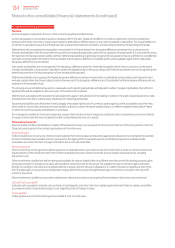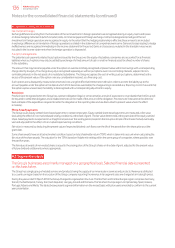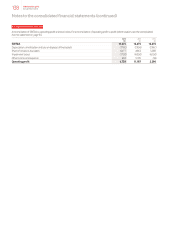Vodafone 2013 Annual Report Download - page 133
Download and view the complete annual report
Please find page 133 of the 2013 Vodafone annual report below. You can navigate through the pages in the report by either clicking on the pages listed below, or by using the keyword search tool below to find specific information within the annual report.
Estimated useful lives
The estimated useful lives of nite lived intangible assets are as follows:
a Licence and spectrum fees 3–25 years
a Computer software 3–5 years
a Brands 1–10 years
a Customer bases 2–7 years
Property, plant and equipment
Land and buildings held for use are stated in the statement of nancial position at their cost, less anysubsequent accumulated depreciation and
subsequent accumulated impairment losses.
Amounts for equipment, xtures and ttings, which includes network infrastructure assets and which together comprise an all but insignicant
amount of the Group’s property, plant and equipment, are stated at cost less accumulated depreciation and any accumulated impairment losses.
Assets in the course of construction are carried at cost, less any recognised impairment loss. Depreciation of these assets commences when the
assets are ready for their intended use.
The cost of property, plant and equipment includes directly attributable incremental costs incurred in their acquisition and installation.
Depreciation is charged so as to write off the cost of assets, other than land, using the straight-line method, over their estimated useful lives,
as follows:
a Freehold buildings 25–50 years
a Leasehold premises the term of the lease
Equipment, xtures and ttings:
a Network infrastructure 3–25 years
a Other 3–10 years
Depreciation is not provided on freehold land.
Assets held under nance leases are depreciated over their expected useful lives on the same basis as owned assets or, where shorter, the term
of the relevant lease.
The gain or loss arising on the disposal or retirement of an item of property, plant and equipment is determined as the difference between any sale
proceeds and the carrying amount of the asset and is recognised in the income statement.
Impairment of assets
Goodwill
Goodwill is not subject to amortisation but is tested for impairment annually or whenever there is an indication that the asset may be impaired.
For the purpose of impairment testing, assets are grouped at the lowest levels for which there are separately identiable cash ows, known as cash-
generating units. If the recoverable amount of the cash-generating unit is less than the carrying amount of the unit, the impairment loss is allocated
rst to reduce the carrying amount of any goodwill allocated to the unit and then to the other assets of the unit pro-rata on the basis of the carrying
amount of each asset in the unit. Impairment losses recognised for goodwill are not reversible in subsequent periods.
The recoverable amount is the higher of fair value less costs to sell and value in use. In assessing value in use, the estimated future cash ows are
discounted to their present value using a pre-tax discount rate that reects current market assessments of the time value of money and the risks
specic to the asset for which the estimates of future cash ows have not been adjusted.
The Group prepares and approves formal ve year management plans for its operations, which are used in the value in use calculations. In certain
developing markets the fth year of the management plan is not indicative of the long-term future performance as operations may not have
reached maturity. For these operations, the Group extends the plan data for an additional ve year period.
Property, plant and equipment and nite lived intangible assets
At each reporting period date, the Group reviews the carrying amounts of its property, plant and equipment and nite lived intangible assets
to determine whether there is any indication that those assets have suffered an impairment loss. If any such indication exists, the recoverable
amount of the asset is estimated in order to determine the extent, if any, of the impairment loss. Where it is not possible to estimate the recoverable
amount of an individual asset, the Group estimates the recoverable amount of the cash-generating unit to which the asset belongs.
If the recoverable amount of an asset or cash-generating unit is estimated to be less than its carrying amount, the carrying amount of the asset
or cash-generating unit is reduced to its recoverable amount. An impairment loss is recognised immediately in the income statement.
Where an impairment loss subsequently reverses, the carrying amount of the asset or cash-generating unit is increased to the revised estimate of its
recoverable amount, not to exceed the carrying amount that would have been determined had no impairment loss been recognised for the asset
or cash-generating unit in prior years. A reversal of an impairment loss is recognised immediately in the income statement.
131 Vodafone Group Plc
Annual Report 2013
Overview Business
review Performance Governance Financials Additional
information








